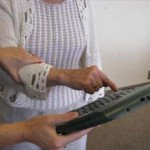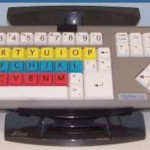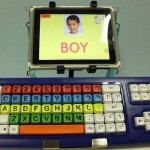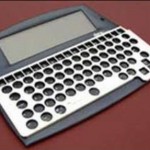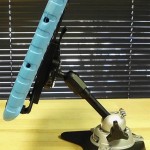The Path to Independence: Step 1 – Facilitator Training
"(Facilitated Communication is) …strongest therapy for people with no means of expression is sensational, controversial, revolutionary, technically subtle FC. It involves understanding movement lapses of people and providing physical support to help overcome them. Plastic nature of users of FC requires topnotch weaning of support towards ultimate goal of independence."
Larry Bissonnette, Independent Typer
Facilitated Communication Training (FCT) is a process that begins with learning the foundational concepts as well as how to get started, and continues through a period of skill building and working toward independence.
The Role of the Facilitator
Access to a trained and qualified facilitator/trainer is key to a non-verbal autistic’s successful journey on the path to independence. The use of proper support techniques is not something that can just be picked up along the way. Many people who express an interest in learning about the method have in mind someone who is currently facilitated or who might benefit from the method. They come to training ready to support someone who is learning to communicate through typing.
The Institute on Communication and Inclusion (ICI) at Syracuse University’s School of Education is the leader of facilitator training in the US. The ICI provides a continuum of training through workshops, monthly skill building sessions, and an annual summer institute. Additionally, the Institute provides referral to trainers for assessments, individual skill building consultations and technical assistance. Their Introductory Trainings, Skillbuilding Workshops and Summer Institutes are intended to teach foundational concepts while developing facilitator and user skills.
Learn more about the Institute on Communication & Inclusion, its mission, the research they support, and the public education material they offer. (website opens in new window)
For an interesting perspective on the qualities needed to be a good facilitator, read Creating Partnerships for Best Practice, Top 10 lists of things to do as a facilitator by FC typers Larry Bissonnette and Tracy Thresher, as well as FC Master Trainers Pascal Cheng, Harvey Lavoy, and Marilyn Chadwick. (PDF opens in new window)
[divider_top]
Introductory Facilitator Training
The two-day Introductory Training Workshop covers the foundational concepts of supported typing and teaches the basic set of skills necessary to become a facilitator. The Institute provides introductory training two times each year in Syracuse and in other locations upon request.
Topics of ICI’s introductory training program include:
[one_half]
- Definition and history of the method
- Connection between movement issues, sensory issues and communication
- Elements of support
[/one_half]
[one_half_last]
- How to get started with supported typing
- Strategies for working toward independent typing
- Authorship and validity of typed communication
[/one_half_last]
[divider_top]
Skillbuilding Workshops
Skillbuilding workshops are geared toward facilitator and user teams that are currently using the method and are looking to further develop their skills or work toward greater independence with the method. These workshops are aimed at:
- Building facilitator skills for problem solving support issues
- Working toward open conversation
- Working toward independent access
In Syracuse, these workshops are currently offered as the Saturday Series. These workshops are also offered in other areas upon request. Individuals who type and their support persons attend these workshops together.
[divider_top]
ICI Summer Institute
Every other summer, the ICI hosts a multi-day summer institute on the Syracuse University campus, featuring national and international keynote speakers, concurrent presentation sessions and hands-on skillbuilding workshops.
The conference draws communication aid users, facilitators, families, teachers and researchers from around the world that are interested in learning about communication and inclusion for individuals who type to communicate.
Visit the ICI website for a recap of the 2013 ICI Summer Institute: Connection, Communication, and Creativity.
During the alternating years when the Summer Institute is not held at Syracuse University, researchers and practitioners from the ICI participate in a Summer Symposium on Facilitated Communication held in Whittier California.
[divider_top]
Total Communication Approach to FC Training:
FC is helpful for those who cannot speak or whose speech is highly limited (e.g. echoed from others or limited to one or a few word utterances) and for people who cannot point independently or reliably because of specific neuromotor difficulties.
Facilitated communication should always be offered as part of a full system of strategies which might include sign language, simple gestures and facial expressions, single words and phrases, and independent pointing.
- FC is not meant to replace current successful communication methods
- It is meant to enhance and expand current communication opportunities
- Many people who type also use some speech, sign, prepared communication boards, dynamic picture displays, etc.
[divider_top]
Facilitator Support on the Path to Independence
In facilitated communication, a person will need physical support, i.e. facilitation to point to selections on a communication board or device. Additionally, the facilitator provides both communication support and emotional support to the trainee.
Physical Support:
[one_half]
- Provides minimal level support
- Creates opportunities for pointing with less physical support
- NO GUIDING – waits for the person to initiate the movement
- Positions the communication device at an accessible angle and height for the person
[/one_half]
[one_half_last]
- Regularly monitors whether the person is looking at the communication device
- Monitors pace and rhythm of person’s pointing movement and adjusts physical support to accommodate changes: nuses more backwards pressure to slow the person down if they begin pointing too rapidly
- Pulls the person’s hand back and brings to a pause to interrupt the pattern of hitting the same selection over and over (perseveration)
[/one_half_last]
Supported Typing Positions
- FC Typing Support Position
- FC Typing Support Position
- FC Typing Support Position
- FC Typing Support Position
[one_half]
- Index finger isolation and extension
- Visual focus
- Accuracy of pointing
- Upright seating position
- Development of deliberate rhythm
[/one_half]
[one_half_last]
- Maintaining slow, even movement
- Decreasing impulsive or automatic movement
- Initiating movement
- Organization of movements – arm/hand positioning
- Attention to task
[/one_half_last]
Communication Support:
- Provides skill reminders to the person about their movement, e.g. “Slow down”, “Reach more for the letters”
- Provides prompts and cues to help a person get started, maintain their focus or continue an interaction, e.g. “What’s the next letter?”, “Keep going”, “Look at what you are doing”
- Provides feedback on what pictures, words, letters a person has pointed to, e.g. ”G-O-space-N-O-W, go now”
- Provides feedback on content of messages and asks clarifying questions, “So you want to go now?” “Yes”, “Tell me where you want to go”
Examples of Assistive Technology (AT) Communication Devices
- AT Device – Big Keyboard
- AT Device – Bluetooth Big Keyboard & Tablet Stand
- AT Device – Keyboard w/ LCD Screen
- AT Device – Adjustable Tablet Stand
- AT Device – Slantboard (front)
- AT Device – Slantboard (rear)
Emotional Support:
- Conveys high expectations and belief in the person’s competence, “I know you can do this”
- Maintains a calm and respectful attitude
- Offers encouragement and positive feedback to build confidence
Movement Differences: What Are They and What Do FC Trainers Need to Know About Them?
One of the abilities a qualified FC trainer needs to develop in order to properly evaluate and guide a typer’s training is the observstion and interpretation of the typer’s physical movements.
Examples of movements a trained facilitator needs to understand include:
- A difference, interference or shift in the efficient, effective use of movement.
- A disruption in the organization and regulation of perception, action, posture, language, speech, thought, emotion and/or memory.
- Movement disturbance can clearly have a profound effect on a person’s ability to regulate movement in order to effectively communicate, relate, and participate with others. It becomes necessary to suspend absolute trust in one’s intuitive interpretation of actions and intent.
- Behaviors may not be what they seem.
“Movement issues for me are a connection difficulty. I hear you ask me to complete a task, but my legs stay put. Through the use of FC I have been better able to get my body to engage in a task. Typing requires thinking and focus. My body has been trained to focus on movement when asked to do something or asked to respond. “
“Movement is essential to communication. I am unable to speak because of apraxia, a movement disorder. I can type because the movement of one finger going up and down is much easier than speaking or sign language. Adding a series of movements as in sign language would be dreadfully frustrating for me. Even simple movements are trying at times. “
Sue Rubin, FC Typer
Understanding Movement Differences
It is known that sometimes people with autism have trouble moving their bodies. This is known as motor planning inability.
- "Sometimes I have trouble making my body do what I want it to do." Jamie Burke, FC Typer
- "Sometimes I like to move in odd ways because it makes me feel more comfortable, yet I have control of some movements. I am also consciously aware of my odd movements at times. Sometimes my movements make me think more clearly." Steven Hinkle, FC Typer
- "I use dear Emily (his facilitator) to communicate with the world. Good communication for me is facilitated through someone giving me grounding by supporting my often spastic appendages." Mark Utter, FC Typer
- "My body movements are jerky and unplanned. My mouth is moving completely independently from my mind. I am trying to get my body where I want it to go, but my body has a mind of its own." Sue Rubin, FC Typer
The facilitator must observe the person doing a variety of activities involving pointing, and look for physical problems that might be affecting pointing. Examples of physical / movement problems include:
[one_half]
- Difficulty isolating an index finger nPointing without looking
- Pointing too quickly
- Difficulty with extending arm / hand
[/one_half]
[one_half_last]
- Initiating movement to point
- Difficulty with new motor tasks, i.e. typing novel communication
- Hitting the same selection or series of selections, e.g. automatic words and phrases, repetitively
[/one_half_last]
Visit the Syracuse University School of Education’s website to read the Institute on Communication & Inclusion’s Training Standards for FC trainers. (opens in new windows)
For a comprehensive look at FC Training, download Rosemary Crossley’s definitive book, Facilitated Communication Training (1999). (PDFs open in new windows)
- Facilitated Communication Training, Part 1 (pages 1 – 75)
- Facilitated Communication Training, Part 2 (pages 76 – 150)
Download the ICI Statement: Handling Sensitive Information and Allegations of Abuse Typed by FC Users: Getting and Giving Support.
[one_half]Previous: Starting Down the Path to Independent Typing[/one_half]
[one_half_last ]Next: Step 2 – Presumption of Competence[/one_half_last]
[divider_top]

